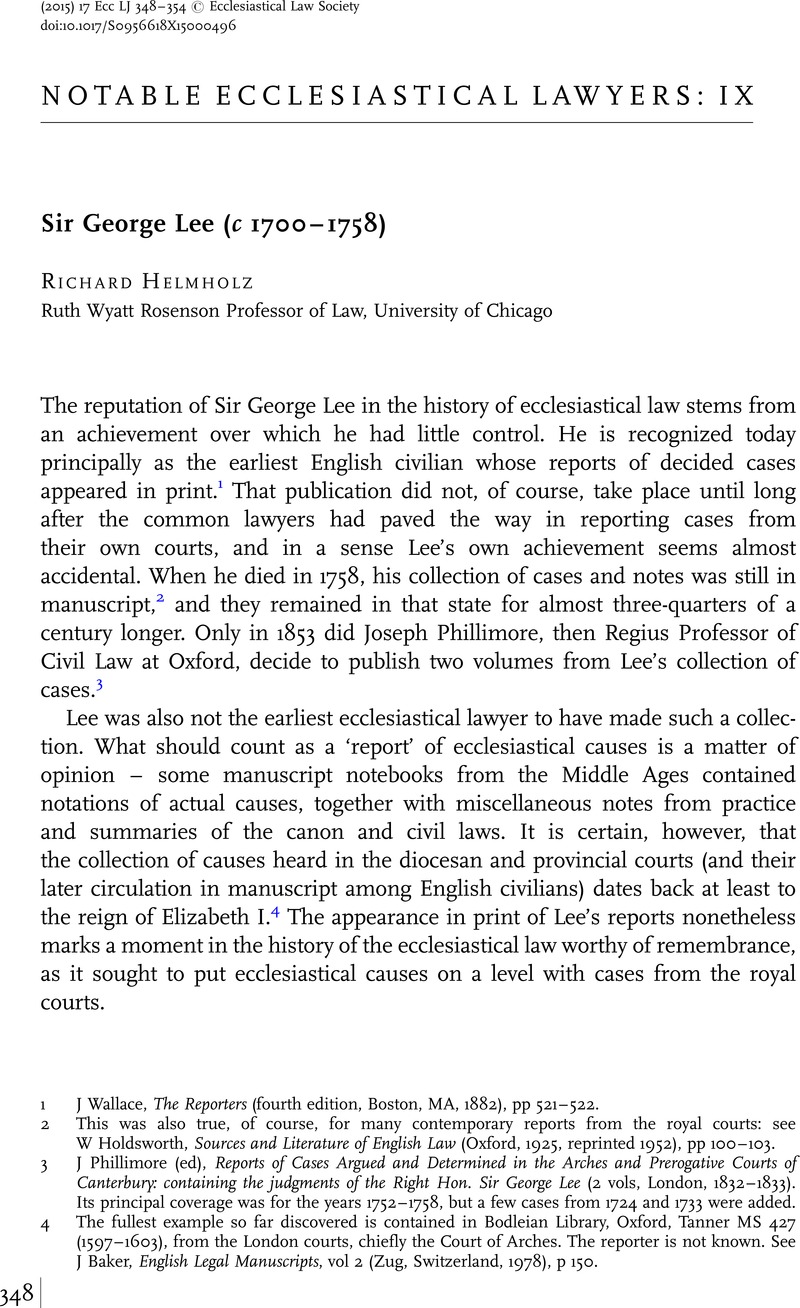Published online by Cambridge University Press: 01 September 2015

1 J Wallace, The Reporters (fourth edition, Boston, MA, 1882), pp 521–522.
2 This was also true, of course, for many contemporary reports from the royal courts: see W Holdsworth, Sources and Literature of English Law (Oxford, 1925, reprinted 1952), pp 100–103.
3 J Phillimore (ed), Reports of Cases Argued and Determined in the Arches and Prerogative Courts of Canterbury: containing the judgments of the Right Hon. Sir George Lee (2 vols, London, 1832–1833). Its principal coverage was for the years 1752–1758, but a few cases from 1724 and 1733 were added.
4 The fullest example so far discovered is contained in Bodleian Library, Oxford, Tanner MS 427 (1597–1603), from the London courts, chiefly the Court of Arches. The reporter is not known. See J Baker, English Legal Manuscripts, vol 2 (Zug, Switzerland, 1978), p 150.
5 This summary of Lee's life was pieced together from M Kilburn, ‘Lee, Sir George’, Oxford Dictionary of National Biography, available at <http://www.oxforddnb.com/view/article/16283>, accessed 10 October 2015; G Squibb, Doctors' Commons: a history of the College of Advocates and Doctors of Law (Oxford, 1977), p 189; C Coote, Sketches of the Lives and Characters of Eminent English Civilians (London, 1804), pp 113–115; and ‘Memoir of Sir George Lee’, in Phillimore, Reports of Cases, vol 1, pp xi–xvii.
6 A Foord, His Majesty's Opposition, 1714–1830 (Oxford, 1964), pp 273–279.
7 Eg in a manuscript letter of M Cottrell (1753), Lambeth Palace Library, MS 2873, fols 9–10, in which he is described as ‘a man of great knowledge and understanding’.
8 They are described by W Holdsworth, History of English Law, vol 12 (London, 1938), pp 666–669.
9 Gardiner v Johnston (1753), 1 Lee 358, 363, 161 ER 132, 134, Prerogative Court of Canterbury. Restraining the number of witnesses was an old problem, one that was never solved: see X 2.20.37 and DD ad id.
10 Eg Plunkett v Sharp (1754), 2 Lee 35, 161 ER 255, Court of Arches.
11 Eg Butler v Dolben (1756), 2 Lee 265, 312, 319, 161 ER 336, 352, 354, Court of Arches.
12 See B Outhwaite, The Rise and Fall of the English Ecclesiastical Courts, 1500–1860 (Cambridge 2006), pp 87–88; but see also Harry v Littleton (1753), 1 Lee 201, 161 ER 75, Court of Arches.
13 Eg Hopper v Davis et al (1754), 1 Lee 640, 161 ER 234, Court of Delegates.
14 Eg Ware v Johnson (1756), 2 Lee 103, 161 ER 279, Court of Arches (on appeal from the Commissary Court of Buckinghamshire).
15 See L Bonfield, Devising, Dying and Dispute: probate litigation in early modern England (Farnham, 2012), pp 133–223.
16 See Outhwaite, Rise and Fall, p 89; M Takahashi, ‘The number of wills proved in the sixteenth and seventeenth centuries', in G Martin and P Spufford (eds), The Records of the Nation (Woodbridge, 1990), pp 187–213 at p 196.
17 This is a principal theme of my Roman Canon Law in Reformation England (Cambridge, 1990); see also M Ingram, ‘Church courts in Tudor England (1485–1603): continuities, changes, transformations', in V Beaulande-Baraud and M Charageat (eds), Les officialités dans l'Europe médiévale et moderne (Turnhout, 2014), pp 91–105.
18 See Catalogue of the Books in the Library of the College of Advocates in Doctors' Commons (London, 1818).
19 Practical ‘tips' for avoiding writs of prohibition were also circulated among the civilians: see eg Clement Colmore's Book (c 1610), Durham University Library, MS DDR/EJ/CCG/2/1, fol 245v.
20 Book of Cases of Sir George Lee, Lincoln's Inn Library, MS 158, fol 80, citing as authority R v Raynes (1698), 1 Salk 299, 91 ER 265, KB.
21 Sutton v Smith (1754), 1 Lee 275, 281, 161 ER 102, 104, Prerogative Court of Canterbury.
22 Lincoln's Inn Library, MS 159, p 3, taking note of a case heard by the House of Lords and also one from the King's Bench, Smith v Tracy (1677), Vent 307, 86 ER 198, KB.
23 Lloyd v Owen and Williams (1753), 1 Lee 434, 437, 161 ER 161, 162, Court of Arches. This was contrary to earlier practice, under which trusts were often established and regulated by the consistory courts, as in Estate of Bell (Bristol 1564), Bristol R O, Act book EP/J/1/6, p 47, where named trustees were to hold property ‘ad usum et commodum’ of the children of the testator.
24 Middleton v Thorpe (recte Crofts) (1736), 2 Atk 650, 653 26 ER 788, 790, KB.
25 Hughes v Herbert (1756), 2 Lee 287, 161 ER 343, Court of Arches.
26 Robins v Wolseley (1757), 2 Lee 421, 443, 161 ER 391, 398, Court of Arches.
27 Keeling v M'Egan (1754), 1 Lee 607, 612, 161 ER 222, 224, Prerogative Court of Canterbury.
28 Skinner v Wells (1740), Lincoln's Inn MS 158, fol 59, London Consistory Court (reference to Cod 5.34.11, and to Antonio Perez (1583–1673), Praelectiones in duodecim libros Codicis ad id).
29 Eg Lee's Commonplace Book, Lincoln's Inn MS 159, p 1 (Lyndwood); Andrews v Powis (1728) 1 Lee 242, 260, 161 ER 90, 96, Serjeant's Inn (Swinburne).
30 Bird v Bird (1753), 1 Lee 209, 212, 161 ER 78, 79, Court of Arches.
31 J Baker, The Law's Two Bodies: some evidential problems in English legal history (Oxford, 2001), pp 59–90.